Driverless tech has reached south-east London: my morning commute in an autonomous pod in Greenwich
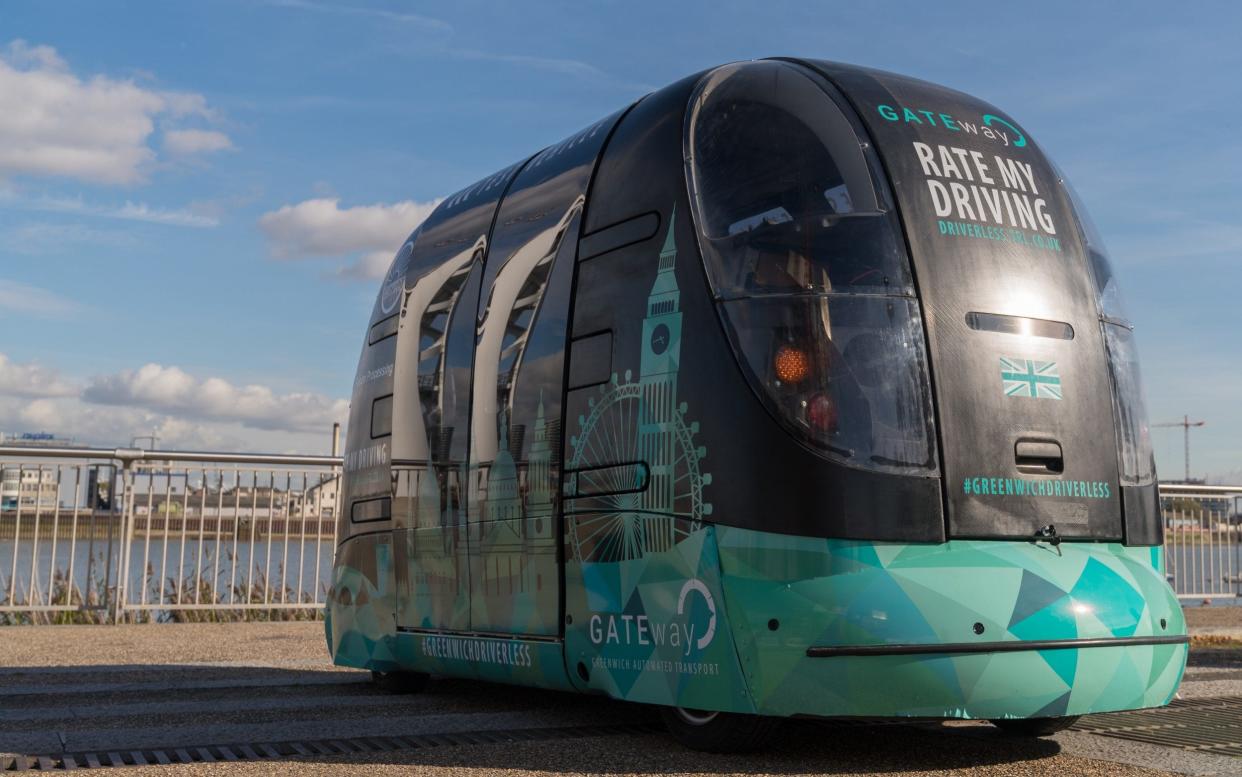
Sir William Lyons, the founder of Jaguar, allegedly said that “the car is the closest thing we will ever create to something that is alive”. It’s a charming sentiment, especially when you think about the models he was referring to, but I’ve come to a drizzly car park in Greenwich to see a more recent human invention that comes much, much closer to sentience.
It’s certainly not a car. It has four wheels, two headlights and some seats inside, but that’s pretty much where the similarities end. This autonomous pod is one quarter of the GATEway (Greenwich Autonomous Transport Environment) fleet currently being trialled on the Greenwich peninsula in south-east London. I’m here to take it on a short journey between my flat and the Thames Clipper pier, simulating a real-world microtransit journey.
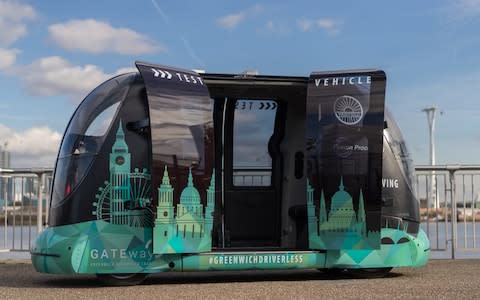
Designers of driverless pods are perhaps prone to cliché. This one is certainly reminiscent of nearly every other fully-autonomous vehicle I’ve seen; invisible wheels, LED lights gleaming through smoked diffusers, a dainty wheelbase and a strange push-me-pull-you symmetry. The pods in Greenwich borrow heavily from those at Heathrow’s Terminal 5, their direct ancestors, though are very much in their developmental infancy. Part of this project is about how the pods could be better designed in future.
Indeed, autonomous pods don’t need to follow a formula. The technology being tested here could be applied to a two-seater, or a 12-seater, or a lorry. The Greenwich pods are used exclusively on paths and pavements, so don’t need the kind of crumple zones and power required for motorway use. Any future vehicles can be optimised for what they’re needed for; more luggage space for applications near airports, external bike racks for connecting two cycle paths, more seats for intensive commuter routes.
Designers of driverless pods are perhaps prone to cliché
This particular vehicle has two inward-facing benches, which can accommodate four adults in comfort and perhaps six in a state of convivial overfamiliarity. The interior design is functional and a little gloomy, like the inside of a light aircraft, with hard plastics reminiscent of older taxis. The doors need to be slammed and only one set will open; the other appears to be held shut with elastic bands.
It’s not sexy. It’s a prototype, and a slightly battered one at that. But as it gets underway and I glance at the safety steward’s hand poised over the emergency stop button, I realise something pretty remarkable: this machine is finding its own way around the world, almost like a living thing.
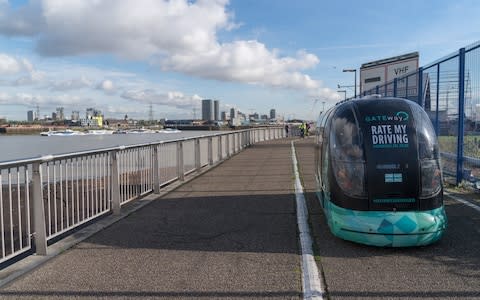
And we’re not in some coned-off car park behind a research laboratory. This is the real world, with pedestrians, cyclists and inattentive suitcase-wheelers. Our corner of London isn’t the busiest but it sees fairly high footfall in the morning and looking through the rainy glass I see dozens of curious faces peering at us. We lurch onto the Thames Path almost silently, our pod only making a noise when it clanks to a halt – something it does with some frequency.
It’s better to be safe than sorry. The prospect of a robotic vehicle hitting a pedestrian is less palatable than the idea of a human driver doing the same, and our pod is being very cautious. If it detects something it doesn’t recognise – its sensors include a camera, Lidar and Radar - it changes direction or comes to a halt, sometimes needing further coaxing to resume its journey. The engineers on this project have built something that behaves like a living creature, albeit a very nervous one.
This machine is finding its own way around the world, almost like a living thing
This project is being run by TRL and a consortium of contributors. There’s a lot going on here – the seeing-feeling element of the pod is made by Fusion, the vehicle itself by Westfield Cars (better known for two-seat roadsters), TRL is the lead organisation spearheading the project, security implications being considered by Imperial College, the RSA insuring the whole thing… I could go on. All of this is being paid for by the government and the wider industry, or industries.
But what’s the point? London has an extensive transport network of buses, trains and the Underground, and even here I’m within a 20-minute walk of the Jubilee Line or the 188. And do people really need vehicles that go this slowly? Would it be better to cycle, or indeed walk?
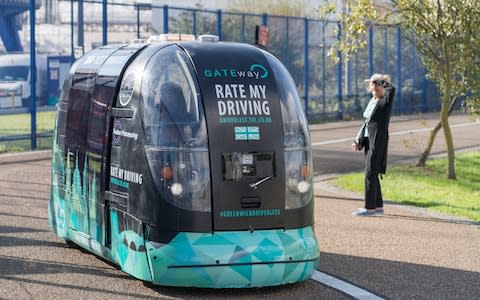
Machines like those being tested in the GATEway project are not going to replace existing transport infrastructure. This is microtransit, sometimes misleadingly referred to as last-mile transport, which connects high-capacity transit links with the communities and buildings where people actually live. In theory, I wake up, leave my flat, climb straight into a driverless pod, then transfer to a rail, road or river connection for the remainder of the journey.
And while the Greenwich peninsula is pretty well connected with the Tube, buses, ferries and even a cable car, it’s also a perfect example of badly-implemented urban design; for all of the eye-catching cladding, stainless steel sculptures and ecology parks, it’s still rife with poor planning, blocked-off paths and unergonomic spaces. The distance between my pod’s start line and the Thames Clipper ferry terminal is 300 yards as the crow flies, but because of the way the peninsula has been developed it’s one mile on foot.
A mile on foot is, by definition, walkable. But how about two, or three? As London expands, the distance between its inhabitants’ front doors and the existing transport network widens, partly due to the convoluted design of new urban spaces but largely because the city is growing quicker than its infrastructure. A fully working driverless pod is a zero-emission, low-noise, ready-to-roll transport network of its own, with the potential to connect people with the places they need to be.
A working driverless pod is a zero-emission, low-noise, ready-to-roll transport network of its own
Car manufacturers are keen to promote autonomous functions of conventional cars, which may one day be able to drive us hundreds of miles. I recently ‘drove’ along several kilometres of French autoroute without touching the steering wheel, thanks to the autonomous ability of the Renault Symbioz. But the more pressing need for driverless tech is here - filling in the transit gaps left by a rapidly over-expanding city.
The rain is clearly a slight impediment. Some judicious wiping with a j-cloth seems to help for a while, but the occasional dribble of rainwater is obstructing one of the sensors’ vision, or is appearing to the on-board computer as an obstacle. This seems like an easy thing to fix (to me, someone who has never built a driverless car) and will no doubt be fixed in the next generation of driverless pod. This machine can trace its ancestry back to the driverless pods at Heathrow Terminal 5, which exist entirely in concrete tracks; it’s amazing how much and how quickly this species has evolved already, and how much potential it has in the future.
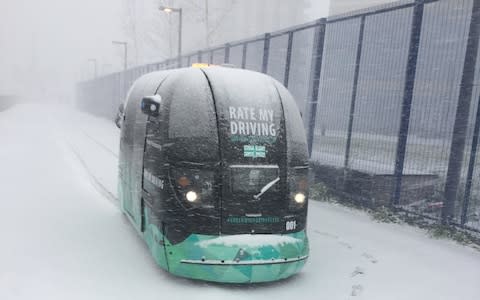
The pod comes to a semi-graceful halt outside the Thames Clipper pier at North Greenwich. I’ll continue my journey on the water, which is underutilised in terms of passenger numbers and which has huge potential for sustainable transit. The Port of London authority estimates that the river’s modest freight traffic keeps 100,000 lorries off London’s roads, so just imagine what the equivalent commuter services could achieve if more people had access to the riverbank.
That’s one of the many possibilities that become available with the roll-out of these microtransit systems. It’s not the only answer; we will still need to significantly reduce the number of journeys we take, and fundamentally challenge our wasteful travel habits before we cement unsustainability into our urban spaces. But this is one of the best answers I’ve seen to the question of sustainable mobility, not to mention the most meaningful application of autonomy I’ve ever encountered. There are hurdles to overcome but the driverless revolution has begun in this blustery corner of SE10.
For tips and advice, visit our Advice section, or sign up to our newsletter here

 Yahoo News
Yahoo News 
